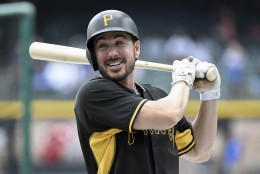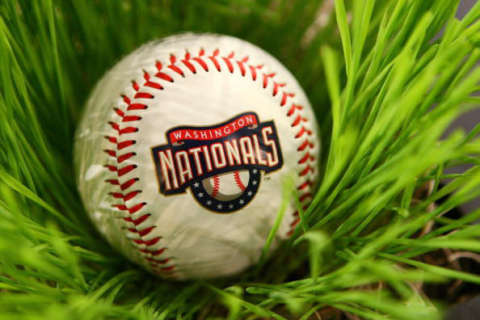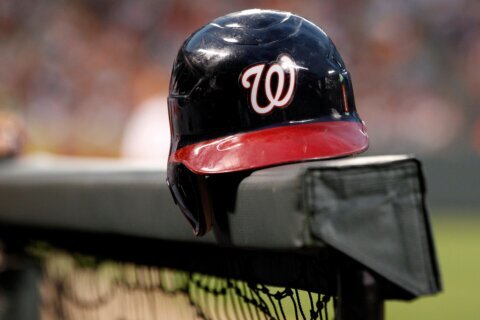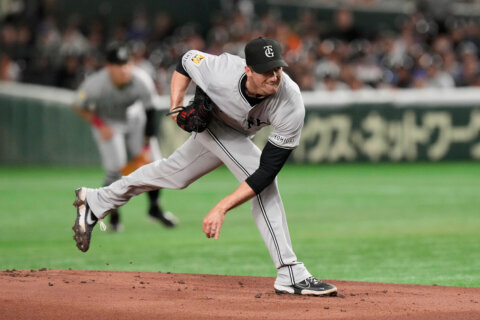

WASHINGTON — The non-waiver trade deadline has come and gone with the Washington Nationals remaining fairly quiet, making just one deal to bolster their bullpen by acquiring reliever Mark Melancon from the Pittsburgh Pirates. But just because the Nats didn’t add a bat in late July doesn’t mean they can’t still do so.
The Aug. 1 deadline (a day later than usual this year) is for non-waiver trades. Two or more teams can agree upon an exchange and, pending any potential no-trade clauses (see Jonathan Lucroy), execute said deal. Come Aug. 2, and running through the end of the month, any player whom a team wants to trade must be put on revocable waivers.
Every team in the league will have a chance to make a claim on said player — starting with the team with the worst record in the same league and working up to the best record, then making the same run in the other league — and then either work out a trade or, at least, block another team from doing so.
If a player is claimed or clears through the waiver process, he can then be traded as he would have been before the deadline. The Nationals have acquired players during this period in past years, including David DeJesus (briefly) in 2013 and Kurt Suzuki in 2012.
Often these players are either the type of bench/utility players who can make it through the waiver process unclaimed, or else players with bloated contracts that no other team would want to be on the hook for. Some teams place entire rosters on waivers (since they can always revoke whomever they want) to cover their intentions to potentially trade individual players. It’s a complex process, but one that allows for a team to add some late help before the Sept. 1 cutoff for playoff rosters.
Before you think about the kind of player the Nats might be wise to acquire, it’s important to look at their greatest areas of need. Nats starting pitchers have easily the highest Wins Above Average of any team in baseball (10.4; Mets are second at 7.0) and the highest of any relief corps in the NL (3.8). But their position-player production has been very average on the whole, specifically being dragged down in a couple of areas.
The Nationals rank next-to-last in WAA in the majors at first base (-2.1) and dead last in center field (-2.2). That has largely been a result of what has been by far the worst season of Ryan Zimmerman’s career and the failed Ben Revere/Michael A. Taylor experiment. None are hitting above .222; none are reaching base at better than a .284 clip, and each is slugging under .400.
Trea Turner has helped, playing capably so far, finding himself in center field as a result. With Zimmerman now on the disabled list, the Nats have been shuffling their defensive alignment to compensate. Sometimes Turner has played second base, with Daniel Murphy moving to first. But regardless of positioning, there remains a void in the lineup.
Finding center field help might be tricky. Colorado’s Charlie Blackmon was reportedly a potential target in July, but GM Mike Rizzo downplayed any interest. Coco Crisp appears to be healthy and might give Washington a veteran, switch-hitting center fielder with the ability to lead off and provide a threat on the basepaths. The A’s are out of contention, and Oakland GM Billy Beane has been Rizzo’s most consistent trade partner.
The tricky thing with Crisp, other than what’s left of his $11 million salary this year, is that he has a $13 million option for 2017 that will vest automatically if he reaches 550 plate appearances. He would need to average roughly 3.5 PA’s per game the rest of the way to do so.
If the Nats choose to leave Turner in center, they can shop for more of a corner outfield/first base type to bolster the offense. After all, Washington has also been poor in left field (-1.4 WAA), but that problem may have a more creative solution than a simple replacement.
Jayson Werth is absolutely crushing left-handed pitching to the tune of a .343/.421/.586 slash line, but has been anemic against righties, slashing just .214/.309/.555. He’s essentially 64 percent better than league average against lefties and 24 percent worse against righties. Unfortunately, he has nearly three times the number of plate appearances against right-handed pitching.
This is where a platoon might make a ton of sense. Werth’s defense in left has been subpar for a while (he has rated as a negative WAR defender every year since turning 30), so you aren’t losing anything on that side of the ball, and could be saving runs by replacing him in the field. Finding a strong platoon in the opposite direction — someone who crushes righties but suffers against lefties — could be a major boon.
Matt Joyce might fit the bill. The Pirates are mired at .500 and looking like the kind of team that would benefit from offloading veterans (like they already did with Melancon) to help rebuild around their core for the future. The left-handed hitting Joyce has always hit righties decently (.254/.352/.454 for his career) and is crushing them this season, to the tune of a .273/.403/.552 mark with 12 home runs in 165 at-bats.
He’s got good patience, doesn’t strike out much and averages 4.34 pitches per plate appearance, which would rank second in the National League (right above Joey Votto) if he had enough at-bats to qualify. He’s also an impending free agent on a $1 million contract, so he wouldn’t cost much in additional salary, always a consideration when discussing in-season trades with the Nationals.
The Pirates have another split-heavy veteran who may help fill a void in John Jaso. While Jaso’s numbers are down this year, he’s been a solidly above-average hitting catching option most of his career and has the positional flexibility to play both first base and in the corner outfield spots. He’s hit 40 of his 41 career homers against righties and has a career .364 on-base percentage against them.
With Jose Lobaton and Ryan Zimmerman both out, Jaso helps cover both positions, and could spell Werth in left when one or both return. As we saw with Kyle Schwarber and the Cubs before his injury, having a third catching option offers another added level of flexibility.
If the Nats do make an addition, they might be wise to consider what kind of positional flexibility their options might offer them, both in terms of filling the obvious voids left by injury as well as those created by poor production. As well as they’ve played to this point, the opportunity to improve is clearly available.







